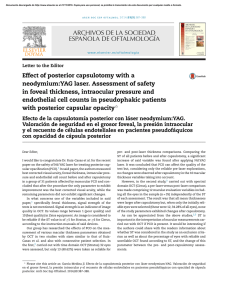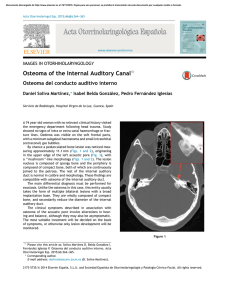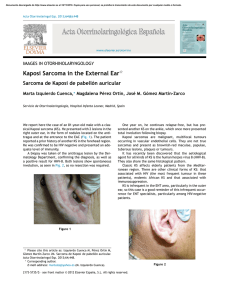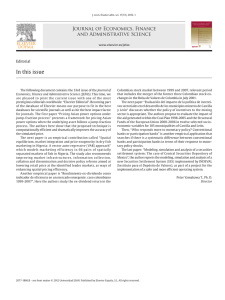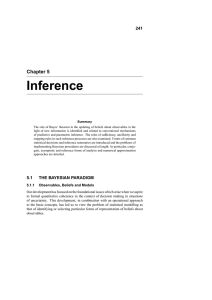Post-traumatic Cholesteatoma With Posterior Fossa Invasion
Anuncio
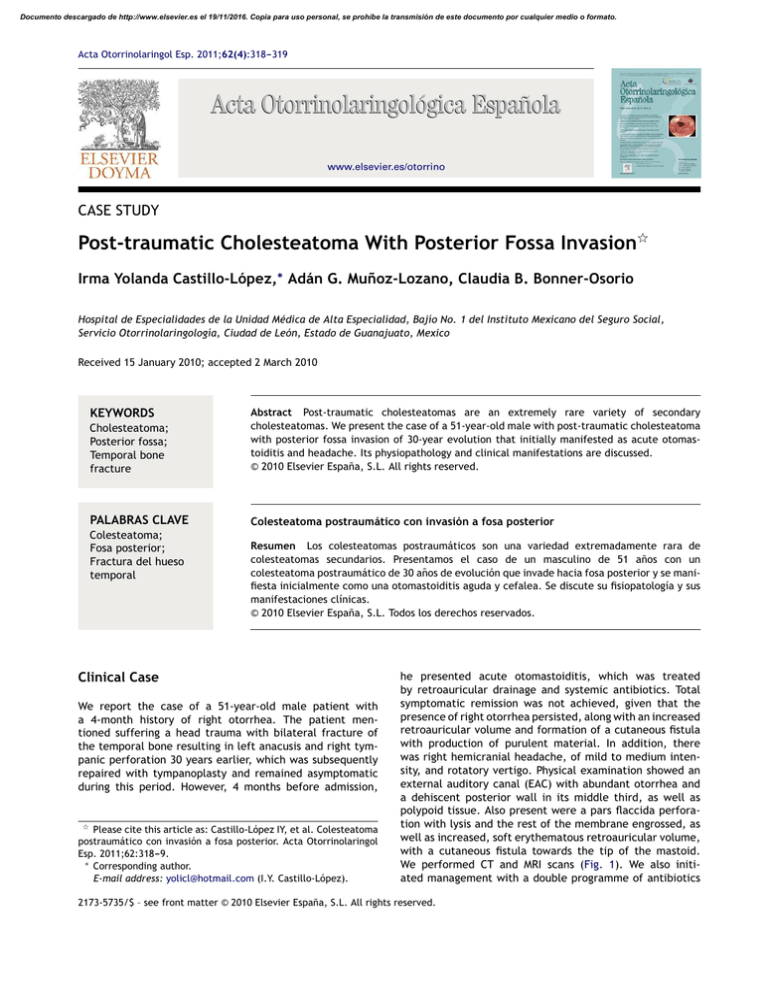
Documento descargado de http://www.elsevier.es el 19/11/2016. Copia para uso personal, se prohíbe la transmisión de este documento por cualquier medio o formato. Acta Otorrinolaringol Esp. 2011;62(4):318---319 www.elsevier.es/otorrino CASE STUDY Post-traumatic Cholesteatoma With Posterior Fossa Invasion夽 Irma Yolanda Castillo-López,∗ Adán G. Muñoz-Lozano, Claudia B. Bonner-Osorio Hospital de Especialidades de la Unidad Médica de Alta Especialidad, Bajío No. 1 del Instituto Mexicano del Seguro Social, Servicio Otorrinolaringología, Ciudad de León, Estado de Guanajuato, Mexico Received 15 January 2010; accepted 2 March 2010 Cholesteatoma; Posterior fossa; Temporal bone fracture Abstract Post-traumatic cholesteatomas are an extremely rare variety of secondary cholesteatomas. We present the case of a 51-year-old male with post-traumatic cholesteatoma with posterior fossa invasion of 30-year evolution that initially manifested as acute otomastoiditis and headache. Its physiopathology and clinical manifestations are discussed. © 2010 Elsevier España, S.L. All rights reserved. PALABRAS CLAVE Colesteatoma postraumático con invasión a fosa posterior KEYWORDS Colesteatoma; Fosa posterior; Fractura del hueso temporal Resumen Los colesteatomas postraumáticos son una variedad extremadamente rara de colesteatomas secundarios. Presentamos el caso de un masculino de 51 años con un colesteatoma postraumático de 30 años de evolución que invade hacia fosa posterior y se manifiesta inicialmente como una otomastoiditis aguda y cefalea. Se discute su fisiopatología y sus manifestaciones clínicas. © 2010 Elsevier España, S.L. Todos los derechos reservados. Clinical Case We report the case of a 51-year-old male patient with a 4-month history of right otorrhea. The patient mentioned suffering a head trauma with bilateral fracture of the temporal bone resulting in left anacusis and right tympanic perforation 30 years earlier, which was subsequently repaired with tympanoplasty and remained asymptomatic during this period. However, 4 months before admission, 夽 Please cite this article as: Castillo-López IY, et al. Colesteatoma postraumático con invasión a fosa posterior. Acta Otorrinolaringol Esp. 2011;62:318---9. ∗ Corresponding author. E-mail address: [email protected] (I.Y. Castillo-López). he presented acute otomastoiditis, which was treated by retroauricular drainage and systemic antibiotics. Total symptomatic remission was not achieved, given that the presence of right otorrhea persisted, along with an increased retroauricular volume and formation of a cutaneous fistula with production of purulent material. In addition, there was right hemicranial headache, of mild to medium intensity, and rotatory vertigo. Physical examination showed an external auditory canal (EAC) with abundant otorrhea and a dehiscent posterior wall in its middle third, as well as polypoid tissue. Also present were a pars flaccida perforation with lysis and the rest of the membrane engrossed, as well as increased, soft erythematous retroauricular volume, with a cutaneous fistula towards the tip of the mastoid. We performed CT and MRI scans (Fig. 1). We also initiated management with a double programme of antibiotics 2173-5735/$ – see front matter © 2010 Elsevier España, S.L. All rights reserved. Documento descargado de http://www.elsevier.es el 19/11/2016. Copia para uso personal, se prohíbe la transmisión de este documento por cualquier medio o formato. Post-traumatic Cholesteatoma With Posterior Fossa Invasion 319 Since it was a single ear, we carried out a modified radical mastoidectomy and obliterated the mastoid cavity with synthetic fibrin and temporal fascia. The patient presented evolved appropriately and was discharged at 7 days postoperative without complications. Discussion Figure 1 MRI scan, T2 sequence. There is a hyperintense mass compressing the right lobe of the cerebellum and penetrating minimally into the middle fossa, without invading the brain tissue. and steroids, and opted for surgical management with transmastoid approach. We found extensive erosion of the cortical mastoid, with cholesteatomatous tissue; erosion of the walls connecting with the middle and posterior fossa, through which the dura mater appeared intact (Fig. 2), and only inflammatory tissue in the epitympanum and aditus ad antrum. The ossicular chain was intact; there was no evidence of cholesteatoma in the tympanic cavity and the posterior wall of the EAC presented wide dehiscence. Post-traumatic cholesteatomas are a well-recognised variety of secondary cholesteatomas.1 It is believed that their formation is due to an entrapment of epithelium in the fracture line, invagination of the epithelium in a consolidated fracture line, traumatic implantation of the tympanic membrane skin into the middle ear, or entrapment of the EAC medial to the stenosis. The fracture lines through the posterosuperior wall of the EAC close and trap the duct skin. This skin grows and expands to form a cholesteatoma.2 There are few cases reported in the literature and they are even regarded as an extremely rare condition.3 Post-traumatic cholesteatomas grow for many years before they are detected because their presence is not suspected until they cause clinical symptoms. This absence of symptoms promotes their extensive growth. The literature contains intervals for their detection ranging between 6 and 29 years.4,5 In our case, the interval was 30 years and growth of the cholesteatoma was extensive, invading the middle and posterior fossae and compressing the cerebellum. Headache is a commonly referred symptom in patients with cases of giant cholesteatoma and intracranial invasion.6,7 It sometimes appears without otological signs.8 In the case presented, the presence of otorrhea, increased retroauricular volume and vertigo pointed to a headache of an otogenic cause. Post-traumatic cholesteatoma is a rare but well recognised late complication of temporal bone fractures. It must be taken into account in patients with a history of temporal bone fractures and associated otological symptoms. References Figure 2 Intraoperative view, where it is possible to observe an autocavity that connects towards the posterior fossa, middle fossa and the mastoid tip, and through which the dura mater can be distinguished. The arrow points to the aditus ad antrum and the asterisk indicates the dura mater covering the cerebellum. 1. McKennan K, Chole RA. Post-traumatic cholesteatoma. Laryngoscope. 1989;99:779---82. 2. Bailey BJ, Johnson JT, Newlands SD. Middle ear and temporal bone trauma. In: Diaz R, Brodie HA, editors. Head and Neck Surgery----Otolaryngology. Philadelphia: Lippincott Williams & Wilkins, p. 2076. 3. Majmundar K, Shaw T, Sismanis A. Traumatic cholesteatoma presenting as a brain abscess: a case report. Otol Neurotol. 2005;26:65---7. 4. Wallwork B, Black B. Middle cranial fossa cholesteatoma following temporal bone trauma. Aust J Otolaryngol. 2002;2:128---30. 5. Goldfarb A, Eliashar R, Gross M, Elidan J. Middle cranial fossa cholesteatoma following blast trauma. Ann Otol Rhinol Laryngol. 2001;110:1084---6. 6. Usuda K, Sakamaki M, Mukono E, Katayama Y. A case of headache attributed to otitis media chronica cholesteatomatica with cerebral sigmoid sinus thrombosis (abstract). J Nippon Med Sch. 2008;75:340---3. 7. Horn KL. Intracranial extension of acquired aural cholesteatoma. Laryngoscope. 2000;110:761---72. 8. McHugh TP. Intracranial cholesteatoma: a case report and review. J Emerg Med. 2007;32:375---9.

